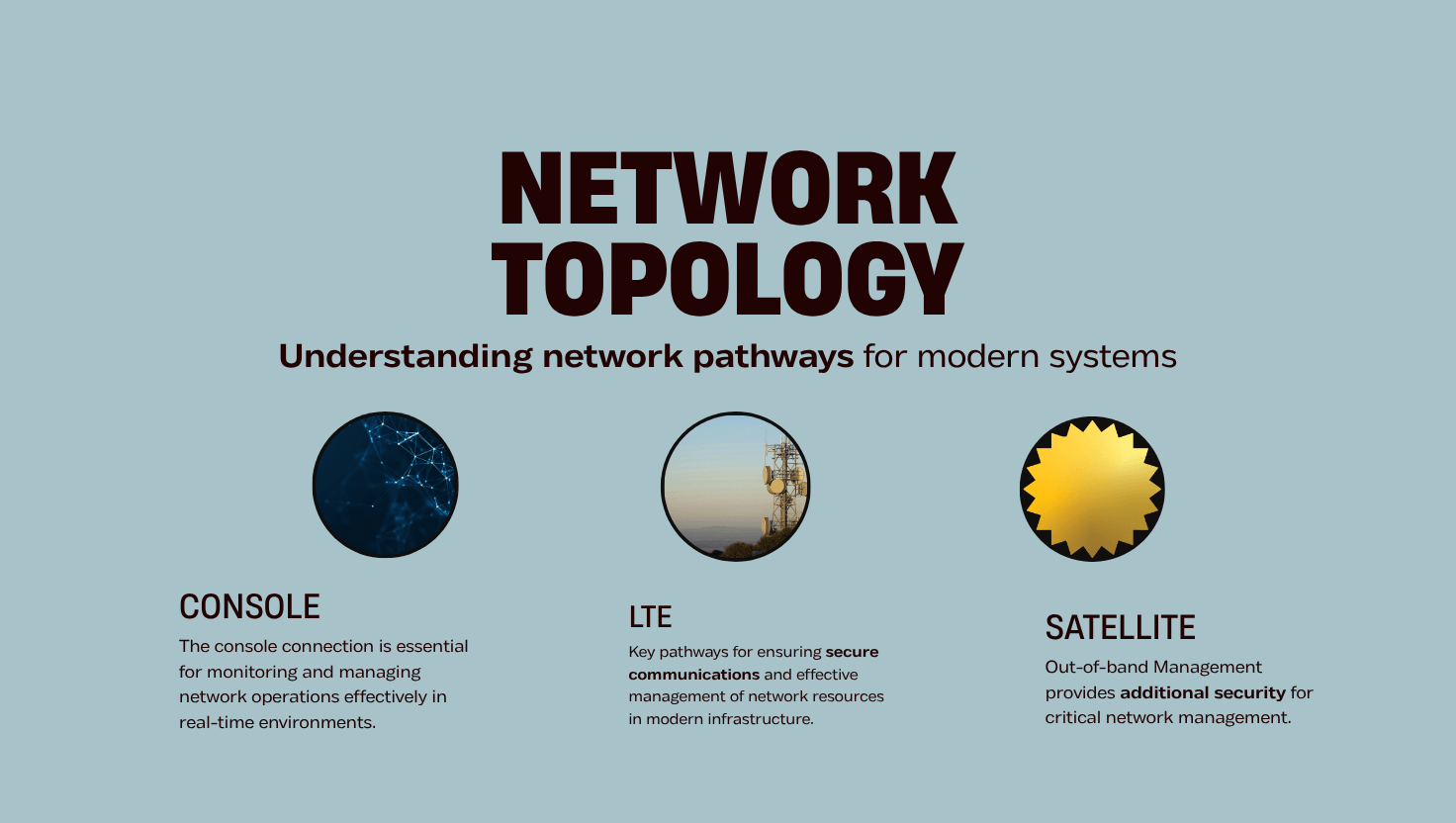LTE Out of Band Management: Ensuring Reliable Connectivity
articles
Adam Cady

LTE Out of Band Management: Ensuring Reliable Connectivity
Can effective network control driven by out-of-band management drive innovation?
In today's digital landscape, reliable communication infrastructure is pivotal, ensuring seamless synergy among devices amidst ever-evolving technological dynamics.
LTE out of band management offers a formidable solution, empowering network administrators with unprecedented control through CDI’s robust serial console ports—transforming potential challenges into opportunities for growth and connectivity.
Imagine a future redefined by precision.
Introduction to LTE Out of Band Management
In a world where uninterrupted connectivity is paramount, LTE out of band management emerges as a beacon of reliability for network infrastructure.
Since 2016, advancements in remote network management have revolutionized how organizations maintain and secure their networks. These innovations have empowered administrators to oversee operations from afar, ensuring optimal performance and enhancing security.
Today, LTE out of band management is a testament to the brilliance of technological evolution. It enables proactive network monitoring, swift troubleshooting, and minimizes downtime, creating a resilient framework that adapts to modern demands.
The essence of leveraging LTE OOB management lies in its ability to provide access to devices at all times, creating an ecosystem where technology and innovation thrive without disruption. It is this harmonious integration that, together with automation, paves the way for future-proof network environments.
Embrace this transformation and witness newfound efficiencies chart the course for progress.
Benefits of LTE Out of Band Management
LTE out of band management stands as a cornerstone in the pursuit of seamless network reliability and security.
In today's interconnected landscape, maintaining consistent access to network devices, regardless of their location, is crucial. LTE out of band management excels by ensuring constant connectivity even during primary network failures, thus granting unhindered access to essential network functions.
This capability empowers IT teams to diagnose and resolve issues quickly and efficiently, reducing downtime and operational disruption through the use of console server and out-of-band management. The result is an agile network environment that consistently meets business demands with unwavering reliability.
Moreover, LTE out of band management's ability to function independently of traditional data channels means that it can be a critical component of any comprehensive disaster recovery strategy. It provides an assurance of continuity when the stakes are highest.
Harness this powerful tool to deliver robust network performance and secure infrastructures, propelling your organization towards extraordinary technological advancement.
Key Features of LTE Out of Band Management
Efficient connectivity during network outages.
LTE out of band management provides seamless connectivity, independent of the main network. This feature enables IT professionals to maintain operational efficiency by leveraging secondary communication pathways, which are crucial for continuous monitoring. Consequently, organizations can enjoy an exceptional level of service continuity, enhancing both reliability and performance.
Improved network reliability through redundancy solutions.
By utilizing LTE technology, out of band management gains an advanced layer of redundancy—ensuring network access remains uninterrupted. This redundancy facilitates real-time troubleshooting and essential updates, even in the face of primary system failures.
Additionally, LTE out of band management strengthens security measures by providing isolated channels for managing network devices remotely. This enhances an organization's ability to quickly mitigate potential security threats and respond to incidents while minimizing risks of intrusion or network compromise. Thus, deploying LTE out of band strategies not only assures continuity but also fortifies the security posture of any forward-thinking enterprise.
Understanding Out of Band Management
Out of band management encapsulates a resilient approach.
At its core, it involves the use of dedicated communication channels for managing network infrastructure. This system ensures that, even when the primary network experiences issues, administrators can still access devices. Such access is vital for ensuring uninterrupted business operations, allowing timely interventions and system updates. Therefore, embracing this methodology becomes fundamental for maintaining robust network health and efficiency.
Out of band management facilitates remote troubleshooting.
Moreover, out of band management is often implemented through technologies such as LTE, serial console ports, and console servers, providing vital communication alternatives, ensuring control over network hardware even when in-band networks are down. These pathways provide vital communication alternatives, ensuring control over network hardware even when in-band networks are down.
This approach integrates cutting-edge technologies and practices, underscoring the importance of innovation and preparedness in network management. As we advance towards 2026 and beyond, leveraging LTE out of band management promises not just to safeguard network integrity but to propel our capabilities for handling unforeseen challenges. It champions an era where connectivity is synonymous with reliability, adaptability, and security, paving the way for future-ready enterprises.
LTE Network Infrastructure
The evolution of LTE network infrastructure symbolizes a remarkable shift, capable of transforming the global communications landscape, transcending geographical limits, and paving the way for seamless connectivity.
LTE network infrastructure offers swift and dependable networks that serve as the backbone of connectivity.
Essentially, LTE’s reach and capacity illuminate unparalleled potential, facilitating IoT (Internet of Things) proliferation and smart devices.
Stakeholders invest in sophisticated infrastructure to harness LTE's capabilities for enhancing and maintaining robust network systems.
This commitment allows for sophisticated resource allocation and maximizes bandwidth efficiency, ensuring network managers can swiftly identify and address any network aberrations, solidifying LTE’s role in network management.
Ultimately, the era of LTE is a testament to human ingenuity, demonstrating what's achievable when cutting-edge technology meets visionary implementation strategies.
Integrating LTE with Out of Band Management
In the dynamic world of network management, LTE out of band management emerges as a linchpin, offering a transformative approach that revolutionizes how network administrators manage distributed networks.
Out of band management ensures that you retain control over network equipment even when primary communication channels fail.
Typically, leveraging LTE technology augments the versatility and resilience of these solutions, enabling rapid (wireless) access to essential management interfaces.
This is especially crucial in situations where immediate intervention is required to rectify and prevent network disruptions, securing continuity and stability.
With the integration of LTE, solutions have the potential to transcend traditional boundaries, facilitating more autonomous network management practices while significantly reducing downtime and operational delays.
Undoubtedly, the future of network management lies in embracing these advancements. Forward-looking network strategies must incorporate LTE out of band management to ensure robust and adaptable systems.
CDI’s Role in LTE Out of Band Management
CDI stands at the forefront of innovation.
As a leader in networking technologies, CDI offers powerful solutions. Their commitment to providing next-level connectivity and security makes them a cornerstone in LTE out of band management. Cisco’s extensive range of products ensures organizations have reliable tools that cater to both current and evolving network challenges, combining reliability with exceptional performance.
CDI’s console servers are crucial.
These servers serve as the backbone of their out of band management strategy, ensuring seamless access and control. With LTE integration, their devices enable continued operation, even amidst unforeseen disruptions, ensuring that network integrity remains uncompromised.
Looking ahead, CDI continues to innovate, setting the standard for efficient and resilient network communication. As of 2025, their comprehensive suite of tools empowers businesses, easing complexities while enhancing network management possibilities. This forward-thinking approach solidifies CDI’s position as a vital force in out of band management, championing more intelligent and flexible infrastructure solutions.
Setting Up Serial Console Port for Management
Mastering the setup of a serial console port is pivotal for unleashing the fullest potential of out of band management in LTE frameworks.
First and foremost, for seamless connectivity, obtaining a reliable console cable that connects the Cisco device's console port to a terminal is indispensable. This straightforward action acts as a gateway into robust management practices by providing uninterrupted access to essential network devices even when the primary network might falter.
Next, configure your terminal emulation software to connect via the serial port. In most cases, setting parameters such as baud rates to 9600, data bits to 8, no parity, and 1 stop bit will align with the console port’s default settings, enabling smooth communication and interaction.
Finally, consider implementing a consistent naming convention for the console connections, ensuring documentation integrity and ease of access. By doing so, you enhance network management proficiency, allowing IT teams to swiftly navigate issues that may arise while maintaining operability. This strategic foresight fosters an environment where troubleshooting becomes not just a task, but a seamless activity that propels network performance and reliability.
Best Practices for Secure Configuration
Implementing secure configuration of LTE out of band management begins with meticulous access control. Have you ensured that only authorized personnel can access critical interfaces?
In 2025, network breaches highlight the necessity for layered security protocols. By adopting multifactor authentication, encryption standards, and role-based access controls, teams can mitigate unauthorized access and bolster security measures when configuring LTE out of band management systems.
Furthermore, it’s vital to ensure that your network’s configurations adhere to a regular review process. Conducting audits and assessments enables the identification of vulnerabilities and ensures adherence to security policies. This proactive approach is indispensable in maintaining robust and resilient network infrastructure.
While the benefits of LTE out of band management are extensive, ignoring secure configurations can have adverse effects. Regularly updating firmware, applying patches promptly, and monitoring logs are essential steps to secure and optimize your network's performance.
Commit to continuous improvement by training staff and investing in tools that simplify configuration management. The journey towards a secure network environment is an ongoing process that demands dedication and vigilance.
Troubleshooting LTE Out of Band Management
Tackling issues with LTE out of band management requires a nuanced understanding of both network and device complexities.
In 2025, organizations increasingly rely on LTE out of band management to ensure network resilience and access continuity. Yet, challenges sometimes arise that require methodical troubleshooting. Recognizing common symptoms such as connectivity disruptions or hardware malfunctions helps pinpoint the underlying causes effectively.
First, confirm that power and connectivity, crucial for LTE devices, are functioning correctly. Inspect the serial console port and associated cables. Malfunctions here can lead to communication breakdowns, underscoring the importance of thorough initial checks.
Next, verify configuration settings on both the device and network management interfaces. Errors in setup or recent updates may introduce issues, so reviewing logs and rollback configurations can resolve potential misconfigurations promptly. Employ diagnostic tools to assess network performance and identify anomalies that may disrupt operations.
In conclusion, effective troubleshooting combines technical acumen with a systematic approach to problem-solving, ensuring LTE out of band systems operate flawlessly.
Common Use Cases for Out of Band Management
Out of band management offers numerous benefits.
One prevalent application is in disaster recovery. By ensuring remote access to network devices during unplanned outages, this management system enables swift recovery and minimizes downtime, keeping mission-critical operations online. Moreover, it is the linchpin of IT infrastructures, particularly in mission-critical scenarios, offering reliability and resilience that bolster operational continuity.
Remote troubleshooting is another critical use.
IT teams can utilize out of band solutions to swiftly diagnose and resolve issues from afar, enabling efficient maintenance without requiring on-site presence. This not only conserves resources but also accelerates issue resolution.
Finally, out of band management plays a pivotal role in security. By utilizing dedicated paths to access network devices outside of standard data traffic, it provides additional security layers, safeguarding against unauthorized access. This rings especially true in an era where data protection is paramount, ensuring that businesses can thrive securely and confidently in a connected world.
Future Trends in LTE Out of Band Management
Embracing technological evolution, the future of LTE out of band management holds immense promise and potential for innovation.
In forthcoming years, advancements in artificial intelligence are poised to revolutionize these systems, facilitating even more efficient, autonomous management. By integrating AI algorithms, these systems can predict potential failures, enabling proactive interventions and reducing downtime. Enhanced machine learning capabilities will further refine analytics, providing insights into network performance that allow for strategic enhancements and optimizations.
Simultaneously, integration with LTE technology will unlock a plethora of opportunities. As networks transition, LTE out of band management can be seamlessly intertwined with cell wireless infrastructures. This connection will empower businesses to leverage the speed and low latency of LTE while maintaining robust out of band solutions.
Looking ahead, we can anticipate that the convergence of enhanced security protocols and cutting-edge processing power will redefine LTE out of band management. As cyber threats evolve, integrating more sophisticated encryption methods alongside advanced processing technologies ensures that these management systems remain impregnable, supporting operational resilience and enabling continuous innovation across the technological landscape.
Selecting the Right Equipment and Technology
To harness the fullest potential of LTE out of band management, selecting the right equipment is paramount.
In this endeavor, one must prioritize acquiring tools with a proven track record, aligning their choices with advancing technology trends. Selecting devices that support both current LTE and emerging standards is essential, ensuring a seamless transition and continuous operational continuity. These technologies must bolster the capacity to manage diverse connectivity demands, providing robust support for network reliability.
Furthermore, there is merit in investing in a platform capable of end-to-end network visibility. By integrating smart analytics, such a solution can swiftly pinpoint anomalies, facilitating prompt corrective actions and maintaining optimal network performance. The strategic choice of such tools enriches network stability and enhances resilience.
Ultimately, pursuing solutions with comprehensive feature sets empowers organizations to remain competitive in a rapidly evolving digital environment. Each tool should be assessed for its scalability, ensuring it can grow and adapt to increase technological demands without compromising function. This strategic foresight fosters the implementation of dynamic solutions that not only withstand current challenges but also embrace future innovations, inspiring confidence and setting new benchmarks in network management excellence.
Related Tags
LTE out-of-band managementLTE connectivityWireless network management4G/5G technologyMobile networksCellular managementRemote access technologytagSerial console portsNetwork infrastructure managementDevice managementNetwork monitoringBusiness continuityTelecommunicationsCritical systems managementNetwork operationsIT infrastructureService providersShare this article
Related Content
United States Office
- 85 Fulton Street Boonton, NJ 07005
- +1 973-334-1980
- +1 973-334-0545
- info@commdevices.com
© 2023 Communication Devices, Inc.







